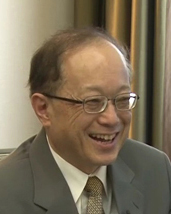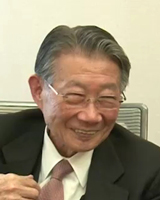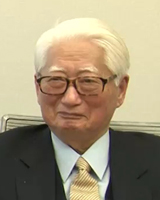| CRN was established in 1996. The importance of the Internet had earlier become recognized when the Great Hanshin Earthquake struck in January 1995. In November of the same year, Microsoft Windows 95 was released which accelerated the popularity of the Internet. Even so, at that time only a few people had considered the idea of establishing a research institution utilizing the Internet. However, Dr. Noboru Kobayashi, who had just participated in a discussion with researchers from various countries regarding the state of children in danger at a conference held in Norway, had a firm intention to "create a research institution open to the world, instead of establishing an institution exclusively for Japanese people." For this reason, he envisaged the establishment of a cyber research center that could be developed by increasing the number of access points around the world. Dr. Kobayashi consulted with Dr. Takemochi Ishii and acquired his support to establish CRN. This year, CRN celebrates its 20th anniversary. |
| | 1-1 | 1-2 | 2-1 | 2-2 | |
CRN was the latest virtual research center
Moderator: Now, we will enter into the second part of our discussion. Twenty years have passed since the foundation of CRN. Dr. Kobayashi, could you please tell us why you decided to create a research center for child science on the Internet?
Dr. Kobayashi: It is difficult to explain in short. When the international conference was held in Norway in 1992, several research projects had already been initiated in the west with the theme of "Child Research" and "Child Studies." I felt that these projects were different from conventional studies which intended to carry out research on children in a limited sense. Rather than this simple concept, it seemed that they offered opportunities to study child issues from a multidisciplinary viewpoint, or places where people related to children from a variety of standpoints could share their opinions. I thought that perhaps the Internet could be an effective tool to realize such concepts.
Moderator: Was there any cyber research center or the like in 1996, when CRN was established?
Dr. Kobayashi: The idea of creating a cyber research center was one of the global trends at that time. However, I was not sure whether it would be possible to realize the idea in Japan, so I had consultations with Dr. Ishii.
Dr. Ishii: I knew that there were several small institutes that had already made a start. One of the largest was at the Shonan-Fujisawa Campus, Keio University. The campus was established in 1990 and started a full-scale internet project from 1991. It was the most advanced among Japanese universities at that time. Everyone, from faculty members to students, used a PC on campus, and all activities, from administrative to academic research activities, were conducted online. Having seen that being done, five years later, in 1996, when I was asked by Dr. Kobayashi about the establishment of a cyber research center, I could confidently say "Yes, you'll definitely do well!"
A human network was where it all started
Moderator: Dr. Ishii, did you already look forward, in the 1990s when the Internet was just opening up, to the reality that the Japanese people would immediately get used to an Internet-based society?
Dr. Ishii: Japan's modern information network originated with the governmental development of the Post Office network, consisting of 26,000 branches across the country which has been in existence since the Meiji era. The number of staff is around 360,000, exceeding that of our military. The scale of the network is enormous compared to other government agencies, efficiently handling the deposit and withdrawal of hundreds of trillions of yen on a daily basis. It is literally one of the largest banks in the world. The Japanese government established the foundation of this network during the Meiji era.
This network is deeply rooted into the lives of Japanese people across the country. The special post offices have been family-run through generations, and around 21,000 branches out of the total of 26,000 branches were operated from their own homes. In terms of how deeply they are rooted in the community, the post office definitely outscores police officers. Without a doubt, post offices are crucial. You can almost say aged people living alone are able to safely survive thanks to the post office system. Since the postman has some means of transportation, he would be asked by local acquaintances during mail delivery to pick up their postal items. In some cases, he would even give someone a ride into town, or drop by to say hello to the elderly at home like a care worker. He would also notice if a stranger appeared, and thus contribute to the security of the neighborhood.
Dr. Sakakihara: This means that a network of information, other than the Internet, was already established in Japan many years ago.
Dr. Ishii: This is what an information network really is. Japan's information network evolved steadily, starting with the post office network, then into telecommunications, and then into the current Internet network.
Dr. Sakakihara: In other words, a human network is the basis of the current Internet network.
Dr. Ishii: In a way, this is the entrainment process like interactions between mothers and babies. Human capital such as Japan's conventional human network is essential to create an effective network system. We need to reevaluate the bond between individuals and societal groups, as one of the strengths of Japanese society, apart from the concept of atomistic individualism in the modern western countries. The connection of mere individuals will not create a good network system, while it is only through the development of the existing human network that will create an effective network system.
Dr. Sakakihara: This could be an inspiring clue to CRN.
Dr. Ishii: The network system will evolve further involving a more sophisticated ICT (Information and Communication Technology), AI (Artificial Intelligence), or IoT (Internet of Things), while maintaining the conventional human network. Although I may sound like I'm coming from both opposite ends, we have nothing to lose through such new technologies so long as the evolution takes place based on humanism as a means of establishing harmonious relations between individuals and groups.

|

|

|
Interactions between people create motivation
Moderator: In terms of childrearing, is it also important for CRN to study the current system of child care, and then, combine both real life and virtual reality?
Dr. Ishii: In the world of business science, for example, there are cases where people fail to create a modern system because they cut out the aspects of a human network. The recent textbook used at Harvard Business School shows the example of Japanese cleaning crews, who are responsible for cleaning the bullet trains when they arrive at their final destination.
Moderator: Oh yes, I have seen them clean the trains at an impressive speed!
Dr. Ishii: It is important to think about what motivates the crews. The job is classified as a "3D (Dirty, Dangerous and Demanding)" the kind of job which no one is willing to take. Nevertheless, the cleaning crews are very motivated to be professional. They line up at the end to bow to the waiting passengers, don't they?
Dr. Sakakihara: For foreigners, this is quite impressive.
Dr. Ishii: I think that the essence of business management is to find out how to create motivation in the workplace. Until recently, business science focused on physical matters such as how much fee to charge. When trying to think in a social capital sense such as mental matters, we will step into the world of brain science; that is, the hypothesis that the social brain is related to social capital, according to brain scientists.
Dr. Sakakihara: This is something to do with incentives. That is, how one can be satisfied at what the person has achieved.
Dr. Ishii: When a child is born, the baby emerges from the mother's body. The baby is thus confronted by a major environmental change, and then creates a communication channel through entrainment. In such a way, the social brain is formed and can be used as much as capital is. At the moment, the concept of the social brain is not recognized as capital. However, brain science is so important now that business science would not make any sense without it.
Dr. Sakakihara: I'm not specialized in this area, but I think that the term "active learning" often referred to by educationalists is related to mutual interaction. Nowadays, the mere term "active learning" has become popular; but in fact, the fundamental idea of active learning is about the synchronization between teachers and learners, or so to say, entrainment.
Dr. Ishii: I agree. Entrainment is very important for the development of human beings. However, people tend to stop thinking about entrainment in the latter part of their life. It is recommended to start thinking about the second senior entrainment in your 40s. We need to further explore this field, but it is worthwhile doing so. The latter part of our life is longer than our childhood, we might have 50 years or longer of it.
Moderator: Recently, the concept of "active care" has become popular among nursing care workers, which places value on active interactions between care workers and the elderly. Apparently, there are a number of advantages, such as retarding the progression of dementia. (To be continued in 2-2)
| | 1-1 | 1-2 | 2-1 | 2-2 | |














